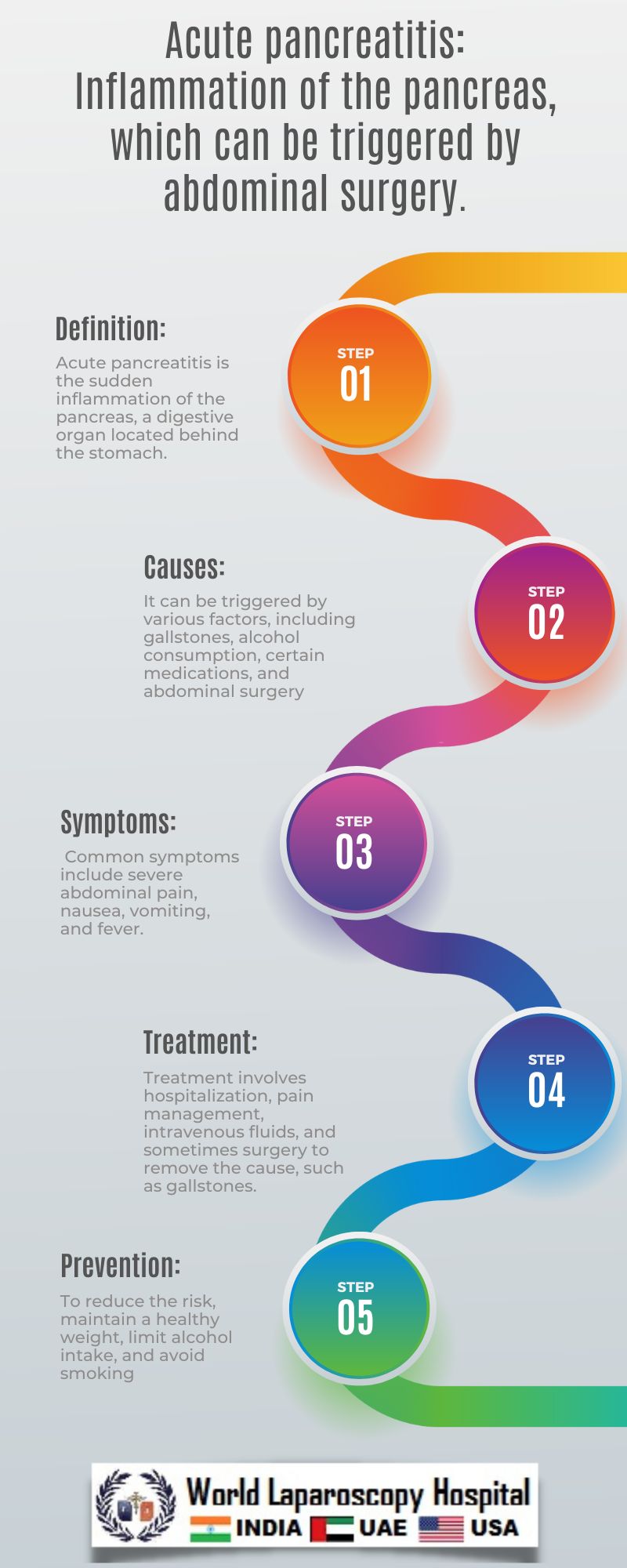Introduction
Acute pancreatitis is a serious condition characterized by the sudden inflammation of the pancreas. This condition can be triggered by various factors, including abdominal surgery. In this comprehensive guide, we will explore the causes, symptoms, diagnosis, treatment, and prevention of acute pancreatitis, with a specific focus on its association with abdominal surgery.

Understanding Acute Pancreatitis
The pancreas is a crucial organ located behind the stomach. It plays a key role in digestion and blood sugar regulation by producing enzymes and hormones. Acute pancreatitis occurs when the pancreas becomes inflamed, leading to severe abdominal pain and other symptoms. This inflammation can be mild and resolve on its own, or it can be severe and life-threatening.
Causes of Acute Pancreatitis
Acute pancreatitis can be caused by various factors, including:
Gallstones: One of the most common causes of acute pancreatitis is gallstones. When a gallstone blocks the pancreatic duct, it can lead to inflammation.
Alcohol consumption: Excessive alcohol consumption can irritate the pancreas, leading to inflammation.
Abdominal surgery: Certain abdominal surgeries, such as gallbladder removal or gastric bypass surgery, can increase the risk of acute pancreatitis.
Trauma: Physical trauma to the abdomen, such as a car accident or a fall, can also cause acute pancreatitis.
Medications: Certain medications, such as corticosteroids, can increase the risk of pancreatitis.
Infections: Viral or bacterial infections, such as mumps or hepatitis, can sometimes lead to pancreatitis.
Symptoms of Acute Pancreatitis
The symptoms of acute pancreatitis can vary from mild to severe and may include:
Severe abdominal pain that radiates to the back
Nausea and vomiting
Fever
Rapid pulse
Swollen and tender abdomen
Jaundice (yellowing of the skin and eyes)
Rapid weight loss
Diagnosis of Acute Pancreatitis
Diagnosing acute pancreatitis typically involves a combination of physical exams, blood tests, and imaging tests. Some common diagnostic tests include:
Blood tests: Blood tests can help determine the levels of pancreatic enzymes, such as amylase and lipase, which are often elevated in acute pancreatitis.
Imaging tests: Imaging tests, such as ultrasound, CT scan, or MRI, can help visualize the pancreas and identify any signs of inflammation or damage.
Endoscopic retrograde cholangiopancreatography (ERCP): In some cases, a special procedure called ERCP may be used to examine the pancreatic and bile ducts for any blockages or abnormalities.
Treatment of Acute Pancreatitis
The treatment of acute pancreatitis depends on the severity of the condition. In mild cases, treatment may involve:
Fasting: Giving the pancreas a rest by avoiding food and fluids for a few days.
Pain management: Using pain medications to help alleviate abdominal pain.
IV fluids: Receiving fluids and electrolytes intravenously to prevent dehydration.
Nutritional support: Gradually reintroducing food and fluids once the inflammation has subsided.
In severe cases of acute pancreatitis, treatment may involve:
Hospitalization: Being admitted to the hospital for close monitoring and intensive care.
Surgery: In some cases, surgery may be necessary to remove any blockages or damaged tissue in the pancreas.
Drainage: Draining any fluid or pus that has accumulated in the pancreas or surrounding areas.
Medications: Using antibiotics to treat any infections that may be present.
Prevention of Acute Pancreatitis
While it may not always be possible to prevent acute pancreatitis, there are several steps you can take to reduce your risk:
Limit alcohol consumption: If you drink alcohol, do so in moderation.
Maintain a healthy weight: Obesity is a risk factor for pancreatitis, so maintaining a healthy weight can help reduce your risk.
Eat a balanced diet: Eating a diet rich in fruits, vegetables, and whole grains can help prevent gallstones, which are a common cause of pancreatitis.
Avoid smoking: Smoking is a risk factor for pancreatitis, so quitting smoking can help reduce your risk.
Be cautious with medications: Some medications can increase the risk of pancreatitis, so talk to your doctor about the risks and benefits of any medications you are taking.
Conclusion
Acute pancreatitis is a serious condition that requires prompt medical attention. By understanding the causes, symptoms, diagnosis, treatment, and prevention of acute pancreatitis, you can take steps to reduce your risk and manage the condition effectively. If you experience symptoms of acute pancreatitis, such as severe abdominal pain or vomiting, seek medical help immediately.